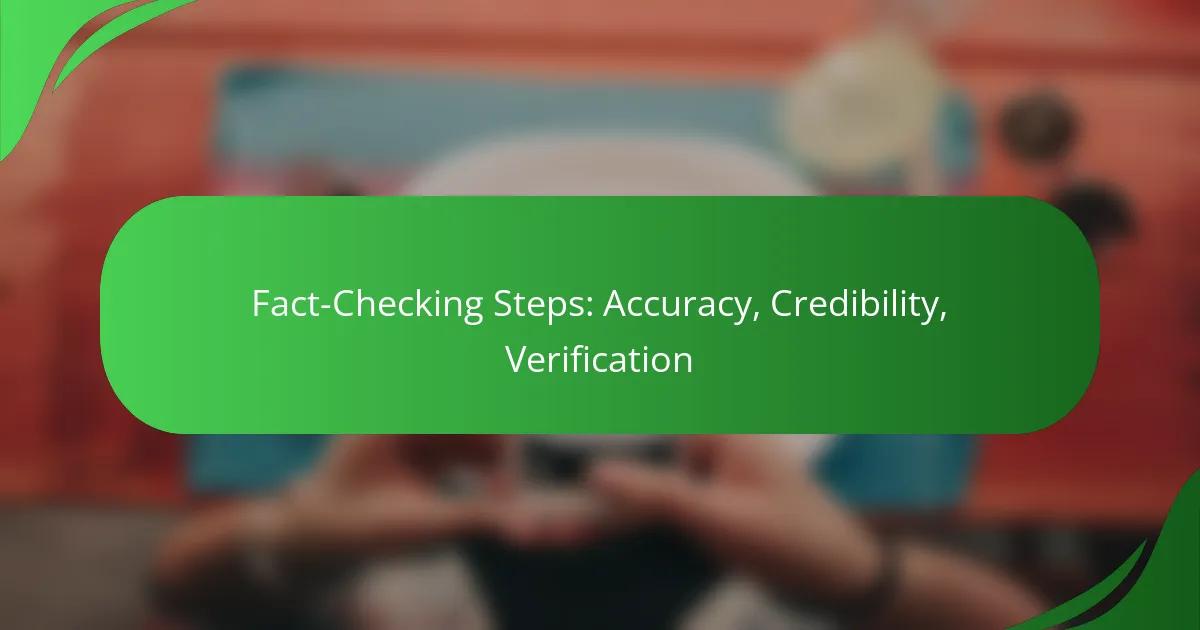Fact-checking is essential for ensuring the accuracy and credibility of information. By systematically verifying claims and assessing the reliability of sources, you can present well-supported and trustworthy content. Utilizing various verification tools further enhances the integrity of the information you share.
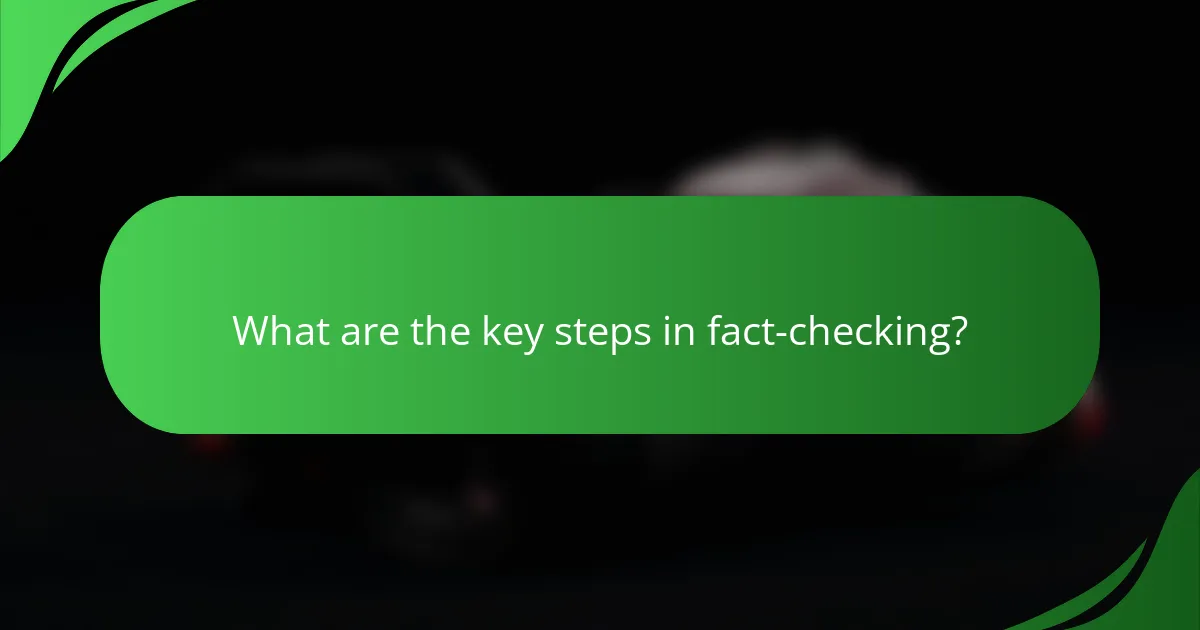
What are the key steps in fact-checking?
The key steps in fact-checking involve a systematic approach to verify the accuracy and credibility of claims. By following specific procedures, you can ensure that the information you present is reliable and well-supported.
Identify the claim
The first step in fact-checking is to clearly identify the claim that needs verification. This involves understanding the statement’s context and implications, which helps in determining what evidence is required for validation.
For example, if a public figure states that a certain policy will reduce unemployment by 50%, the claim needs to be dissected to understand the basis of that assertion.
Gather evidence
Once the claim is identified, the next step is to gather relevant evidence. This includes collecting data, statistics, and other information that can support or refute the claim.
Utilize various sources such as research studies, reports, and historical data. Ensure that the evidence is recent and applicable to the specific claim being analyzed.
Consult reliable sources
Consulting reliable sources is crucial in fact-checking. Use established databases, reputable news outlets, and expert opinions to verify the information you have gathered.
Look for sources that are known for their accuracy and credibility, such as academic journals or government publications. Avoid sources that lack transparency or have a history of misinformation.
Cross-verify information
Cross-verifying information involves checking multiple sources to confirm the accuracy of the evidence. This step helps to identify any discrepancies or biases in the information.
For instance, if different studies report varying unemployment rates, analyze the methodologies used in each to determine which is more reliable. This can prevent the spread of false information.
Document findings
Finally, document your findings in a clear and organized manner. This includes noting the sources of your evidence, the conclusions drawn, and any uncertainties that remain.
Creating a summary report can be helpful for future reference and for sharing your findings with others. Ensure that your documentation is transparent and accessible for verification by others.
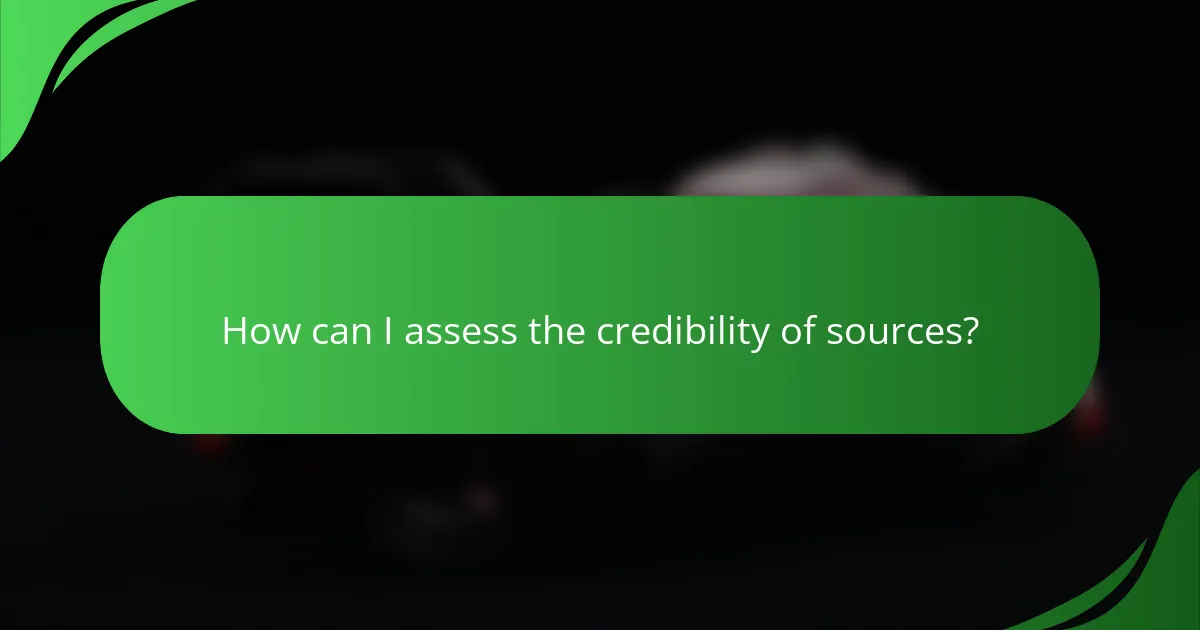
How can I assess the credibility of sources?
To assess the credibility of sources, consider the author’s qualifications, the reputation of the publication, and the presence of citations and references. These factors help determine whether the information is reliable and trustworthy.
Check author qualifications
Evaluating the author’s qualifications is crucial for determining credibility. Look for their educational background, professional experience, and any relevant publications. An author with expertise in the subject matter is more likely to provide accurate information.
For example, an article on medical topics should ideally be written by a healthcare professional or researcher. Checking the author’s profile on platforms like LinkedIn or academic databases can provide additional insights into their qualifications.
Evaluate publication reputation
The reputation of the publication plays a significant role in assessing source credibility. Established journals, reputable news outlets, and academic publishers typically have rigorous editorial standards. Sources that are well-known for fact-checking and accuracy are generally more trustworthy.
Consider whether the publication has a history of reliability. For instance, peer-reviewed journals are often more credible than personal blogs or unverified websites. You can also check if the publication has received any awards or recognition in its field.
Look for citations and references
Credible sources often include citations and references to support their claims. This transparency allows readers to verify the information and assess its accuracy. Look for links to original studies, data, or expert opinions that back up the content.
A good practice is to check the number and quality of references. Sources that cite peer-reviewed articles or reputable organizations are generally more reliable. If a source lacks citations or relies heavily on anecdotal evidence, it may be less credible.
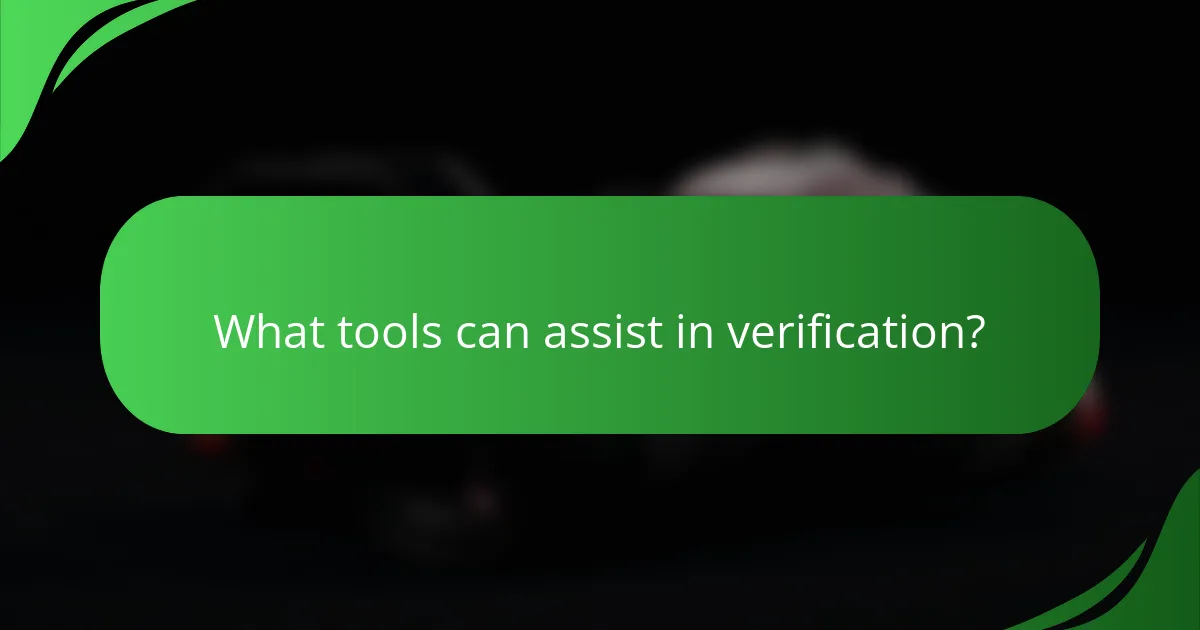
What tools can assist in verification?
Several tools can aid in verification, enhancing the accuracy and credibility of information. These tools range from specialized websites to software designed for detecting image manipulation and plagiarism.
Fact-checking websites
Fact-checking websites are platforms dedicated to verifying claims made in public discourse. They typically analyze statements from politicians, media, and other public figures against credible sources to determine their truthfulness.
Popular fact-checking websites include Snopes, FactCheck.org, and PolitiFact. These sites provide detailed analyses and sources, making it easier for users to understand the context and reliability of the information presented.
Image verification tools
Image verification tools help assess the authenticity of images by checking for alterations or confirming their origin. Tools like TinEye and Google Reverse Image Search allow users to upload images and find their sources or similar images online.
When using these tools, look for discrepancies in image metadata or signs of manipulation. This can help identify whether an image has been misrepresented or taken out of context.
Plagiarism detection software
Plagiarism detection software identifies instances of copied content across various sources. Tools like Turnitin and Grammarly’s plagiarism checker scan documents against extensive databases to ensure originality.
When using plagiarism detection tools, consider the percentage of similarity reported. A low percentage typically indicates original content, while higher percentages may require further investigation or citation adjustments.
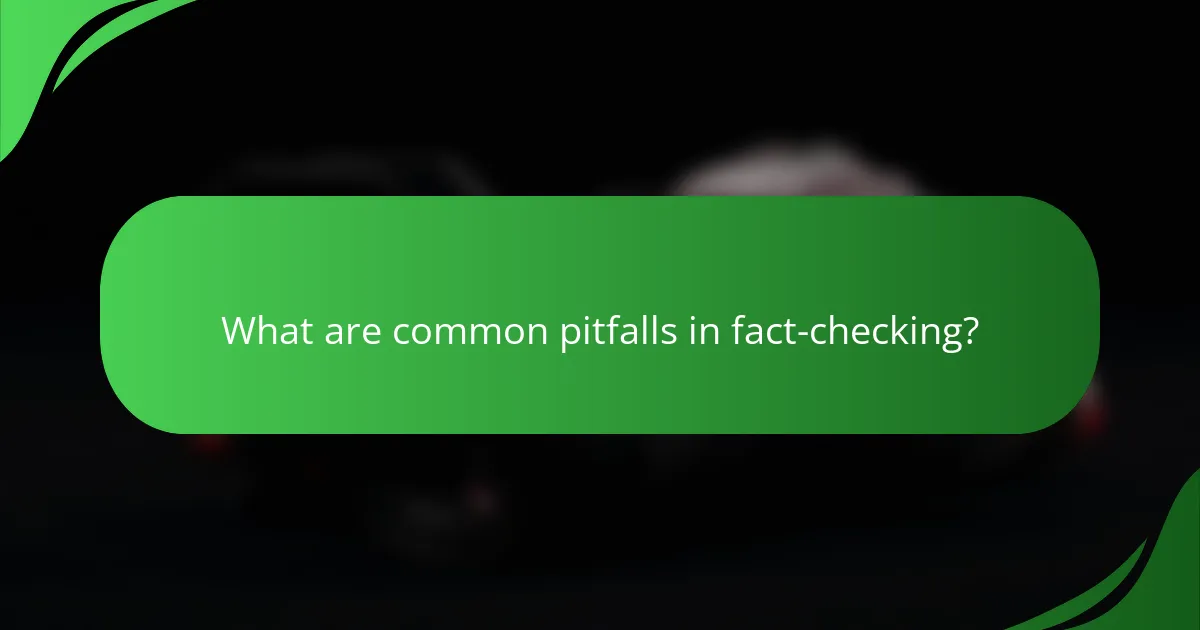
What are common pitfalls in fact-checking?
Common pitfalls in fact-checking include biases, lack of context, and over-reliance on social media sources. These issues can lead to misinformation and undermine the credibility of the fact-checking process.
Confirmation bias
Confirmation bias occurs when individuals favor information that aligns with their pre-existing beliefs while disregarding contradictory evidence. This can distort the fact-checking process, leading to an incomplete or skewed understanding of the facts.
To mitigate confirmation bias, actively seek out diverse sources and viewpoints. Challenge your assumptions by considering evidence that contradicts your beliefs, which can lead to a more balanced perspective.
Ignoring context
Ignoring context can result in misinterpretation of facts or statements. Facts often depend on surrounding circumstances, and without this context, the information may be misleading or incorrect.
Always consider the broader situation when evaluating claims. Ask questions like who, what, where, when, and why to ensure a comprehensive understanding. For example, a statistic about crime rates may vary significantly based on geographic or temporal context.
Over-reliance on social media
Over-reliance on social media for fact-checking can lead to the spread of misinformation. Social media platforms often prioritize engagement over accuracy, making it easy for false information to circulate widely.
To avoid this pitfall, cross-reference information from social media with reputable news outlets or official sources. Use established fact-checking websites to verify claims before accepting them as true. This approach helps ensure that the information is credible and accurate.
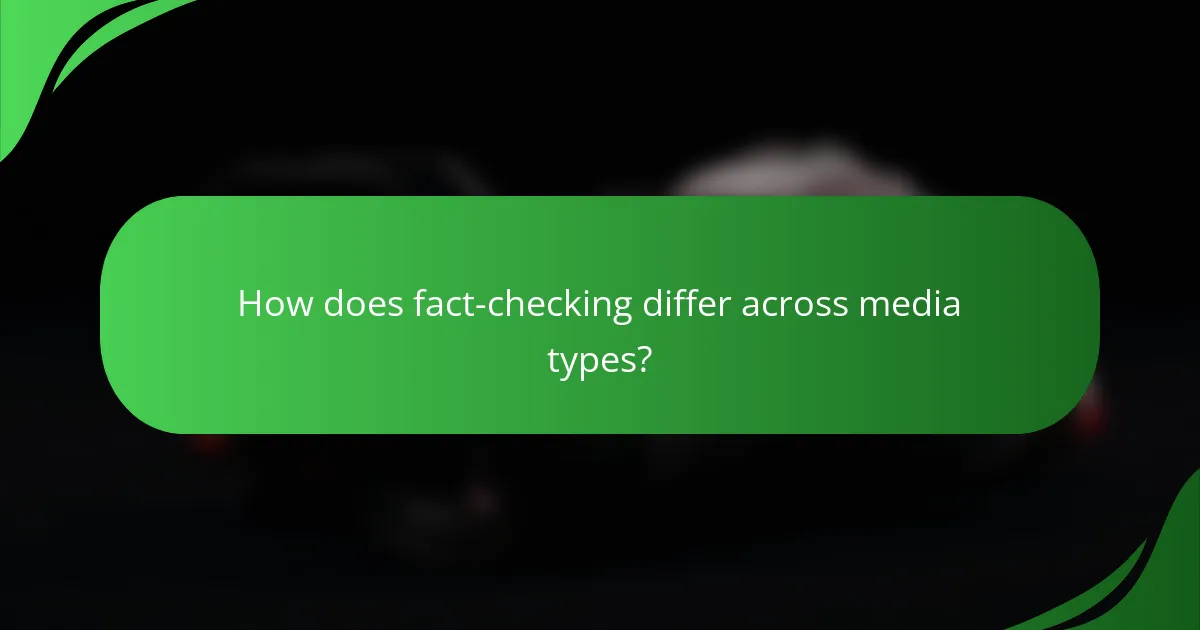
How does fact-checking differ across media types?
Fact-checking varies significantly across different media types, influenced by their formats and audiences. Print, broadcast, and digital media each have unique protocols and standards for verifying information, impacting how accuracy and credibility are maintained.
Print Media
In print media, fact-checking typically involves a rigorous editorial process where multiple sources are consulted to verify claims before publication. This often includes cross-referencing with established databases and expert interviews to ensure accuracy.
Common pitfalls in print fact-checking include reliance on outdated sources or failing to update information before going to print. Editors should implement a checklist to confirm that all facts are current and sourced from credible references.
Broadcast Media
Broadcast media fact-checking focuses on real-time verification, which can be challenging due to time constraints. Journalists often rely on trusted sources and rapid information gathering to confirm facts before airing news segments.
To enhance credibility, broadcasters should establish partnerships with fact-checking organizations and utilize social media to gather immediate feedback from audiences. This can help identify inaccuracies quickly and maintain trust with viewers.
Digital Media
Digital media fact-checking is often more decentralized, with various platforms allowing user-generated content. This necessitates a strong emphasis on community moderation and the use of automated tools to flag potential misinformation.
Digital platforms should encourage users to report inaccuracies and provide clear guidelines for fact-checking processes. Implementing a transparent verification system can help users discern credible information from unreliable sources.
